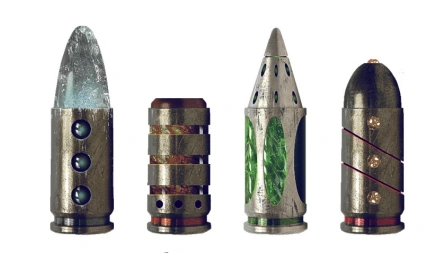Some wiki articles and cutaways of frag bolts show them having a proximity detonator.Hm, your numbers actually line up roughly with mine, of roughly 1 meter and 20 meters. Keep in mind with the comparison to the 20x102 round you are talking about something a bit bigger than I was picturing: the statted out 75 caliber I made has an overall length of roughly 100 mm. the 102mm length on the 20mm refers just to the cartrige: confirmed that by comparing it to the size of a display 50 cal round I have, with a 99 mm case and overall length of roughly 140mm.

Overall the Vulcan round is roughly 170 mm, almost twice as long as my assumption for a the 75 cal bolter. The gyroget nature also means you can't flair out the cartridge for more propellant like the vulcan does, and is shorter due to handling limits: If you have tape measure, 100 mm is already pushing what can reasonably be handled as a magazine by normal human scale hands.
Given the smaller size, I'm actually quite happy with my estimate. You may be correct about danger range, and them being dangerous: 1 meter kill zone more or less guarantees any hit anywhere is instantly lethal, useful against tougher enemies or even in modern situations with good medical care to guarantee a kill, rather than a recoverable wounded.
10-20 shrapnel danger range is also quite significant comparing to terrain features: checking on google maps intersections and street widths in built up areas, the streets and intersections are only about 20-30 meters wide, building to building. One bolter then, as long as it has some trigger to explode properly, could thus cover the entire street in some light shrapnel, suppressing the entire area single handedly. A lot of houses are also in the 20-30 meter overall dimensions, so depending on penetration of the rounds bolter round exploding in a house have a better chance of wounding someone in the house than basic fire.
Getting the most of any of these does require getting the right fusing, either to detonate at a certain distance, or after the right resistance (detonating after penetrating glass or vehicle armor probably takes a different sensitivities). But, that's just points to the advantage of having adjustable fuses like bellow, or building different classes of bolter ammo with differently optimized fuses. This is very old tech, so not out of question at all.

It would be quite useful is the bolter could adjust the fuses on the fly: for example, a range finder pointed at the target measures distance and programs the bolter explode at that distance, so even if the target somehow dodges, the bolter round will still explode in close proximity to the target. Or dial in a range so when supressing a street or intersection all the bolters air burst right in that intersection, rather than having to do arching fire or make sure there's some target to hit.
I could see space marine bolters have such a feature. More questionable with the Guard. Then again, adjustable fuses are WWI-II tech, and I believe WWII did have guns which could automatically set time fuses during the loading process. So it wouldn't be totally out of place for at least heavy bolters to have some programable detonation range the gunner can set detonation to.
Would also help justify the bulkiness if there was a fuse programmer in that big brick. Also go a long way to justify one reason why bolters might be considered preferable to lasgun fire when available.
Also, due to bolt rounds being part rocket, i'd wonder if their design could cheat a little bit and re-use the left over rocket section of the bolt as additional fragmentation material.
The 20mm OICW cancellation illustrates well the reason for not using advanced fuzes in very small rounds. Unless they can be miniaturized really hard (the 40k cutaways suggest they can do it for Astartes), fuzes can badly cut into the round's payload.


